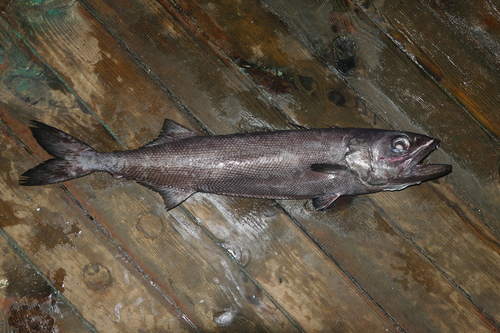
Oilfish
The Atlantic bluefin tuna (Thunnus thynnus) is a magnificent and highly migratory species of tuna found in the Atlantic Ocean and the Mediterranean Sea. Renowned for its size, speed, and commercial value, it plays a crucial role in the marine ecosystem. This species is one of the largest bony fish, capable of transoceanic journeys.
9 12 years
Lifespan
300 cm
Length
Least Concern
Conservation Status
15 km/h
Swimming speed
Carnivorous
Diet
Local Migration
Migration
Appearance Overview
The Atlantic bluefin tuna is a large, streamlined fish with a metallic blue body and a silvery underside.
Color
Dark metallic blue above, silvery white below
Body Shape
Torpedo-shaped, built for speed and endurance
Fins
Two dorsal fins, the first depressible; small finlets running down the body towards the tail
Length
Up to 13 feet (4 meters), commonly around 6.5 feet (2 meters)
Weight
Up to 2,000 lbs (900 kg), commonly around 550 lbs (250 kg)
Diet
Carnivorous, feeding on a variety of fish, squid, crustaceans, and eels.
Feeding Behavior
Highly active predator, using speed and agility to hunt. They often hunt cooperatively, herding and surrounding prey.
Social Behavior
Forms large schools, especially during migration and spawning. Schools may be segregated by size.
Commercial Relevance
Extremely high value, particularly in the sushi and sashimi markets in Japan. Overfishing to meet this demand has significantly impacted populations.
Conservation measures
International fishing quotas, seasonal closures, minimum size limits, and efforts to reduce bycatch. Marine Stewardship Council (MSC) certification is available for some fisheries.
Status
Varies by population; Western Atlantic stock is considered Endangered, while the Eastern Atlantic and Mediterranean stock is considered Least Concern but with ongoing concerns.
Threats
Overfishing (historically and ongoing in some areas), bycatch in other fisheries, climate change affecting prey distribution and spawning grounds.
Habitat Distribution
Depth Range
Surface waters to depths of over 3,000 feet (900 meters), although they spend most of their time in the upper layers of the ocean.
Geographic Range
Found throughout the North Atlantic Ocean, including the Mediterranean Sea. Two main populations exist: Western Atlantic and Eastern Atlantic/Mediterranean.
Preferred Environment
Primarily pelagic (open ocean), inhabiting temperate and subtropical waters. They undertake long migrations across the Atlantic.
Reproduction and Life Cycle
Breeding Habits
Spawning occurs in warm waters, with the Western Atlantic population breeding in the Gulf of Mexico and the Eastern population in the Mediterranean Sea.
Development Stages
Eggs hatch into larvae, which develop rapidly in plankton-rich waters. Juveniles grow quickly, reaching significant size within their first year.
Fecundity
Highly fecund; a single female can release up to 30 million eggs per spawning season.
Maturity Age
Western Atlantic stock: matures around 8-12 years. Eastern Atlantic and Mediterranean stock: matures earlier, around 4-5 years.
Faqs about Oilfish
How long do Atlantic bluefin tuna live?
Atlantic bluefin tuna can live for up to 40 years, although this is becoming increasingly rare due to fishing pressure.
How fast can Atlantic bluefin tuna swim?
They are among the fastest fish in the ocean, capable of reaching speeds of up to 43 mph (70 km/h) in short bursts.
Are Atlantic bluefin tuna warm-blooded?
Yes, they are warm-blooded, which allows them to maintain a body temperature higher than the surrounding water. This helps them survive in a wide range of temperatures and hunt effectively.
Where do Atlantic bluefin tuna spawn?
The Western Atlantic stock spawns primarily in the Gulf of Mexico, while the Eastern Atlantic and Mediterranean stock spawns in the Mediterranean Sea.
Why is bluefin tuna so expensive?
Bluefin tuna meat is prized for its high fat content, rich flavor, and firm texture, making it ideal for sushi and sashimi.
Can bluefin tuna dive deep?
Yes, they can dive to the depth of 3000 feet.
Copyright @ Nature Style Limited. All Rights Reserved.
 English
English